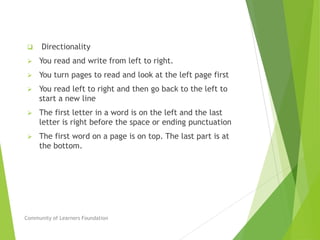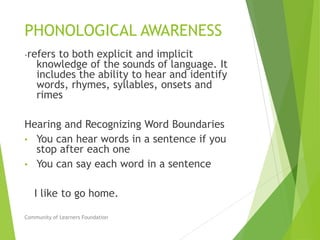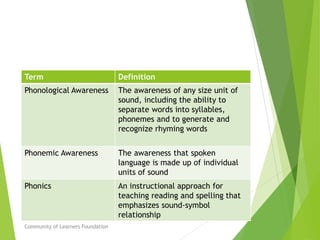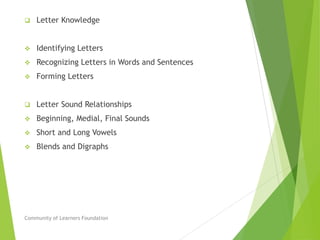PPT Supporting Children's Reading Development.pdf
- 1. Supporting Children¡¯s Reading Development Community of Learners Foundation
- 2. ? Reading is not a natural ability. Speaking is innate, reading is not. ? Learning to read starts with the AWARENESS that speech is composed of individual sounds (phonemes) and a recognition that written spellings represent those sounds. (Alphabetic Principle). Community of Learners Foundation
- 3. EARLY LITERACY CONCEPTS ? Distinguishing between print and pictures ? Print and pictures are different but are connected ? You read the print, not the picture ? Understanding a concept of a letter ? There is a difference between a word and a letter. ? A letter has a name and a shape. ? A letter or a group of letters represent a sound. ? A letter has a shape and has features. ? A letter is always the same and you look at the parts to identify it. ? There are uppercase and lowercase letters. ? . Community of Learners Foundation
- 4. ? Understanding a concept of a word ? A word is a group of letters that mean something. ? A word in writing is a group of letters with space on either side. Community of Learners Foundation
- 5. ? Directionality ? You read and write from left to right. ? You turn pages to read and look at the left page first ? You read left to right and then go back to the left to start a new line ? The first letter in a word is on the left and the last letter is right before the space or ending punctuation ? The first word on a page is on top. The last part is at the bottom. Community of Learners Foundation
- 6. ? Understanding the concept of the first and last in written language * first word in a sentence- left * last word is before a period or question mark * first letter of a word is on the left * the first part of a page is on top * the last part is at the bottom ? Understanding that one spoken word matches one group of letters ¡° We say one word for each word we see in writing ¡° Community of Learners Foundation
- 7. PHONOLOGICAL AWARENESS -refers to both explicit and implicit knowledge of the sounds of language. It includes the ability to hear and identify words, rhymes, syllables, onsets and rimes Hearing and Recognizing Word Boundaries ? You can hear words in a sentence if you stop after each one ? You can say each word in a sentence I like to go home. Community of Learners Foundation
- 8. Term Definition Phonological Awareness The awareness of any size unit of sound, including the ability to separate words into syllables, phonemes and to generate and recognize rhyming words Phonemic Awareness The awareness that spoken language is made up of individual units of sound Phonics An instructional approach for teaching reading and spelling that emphasizes sound-symbol relationship Community of Learners Foundation
- 9. Phonemic Awareness - involves the auditory and oral manipulation of sounds Phonics is an instructional approach that builds on the alphabetic principle and associate letters and sounds with written symbols. Simply learning letter-sound relationships during phonics instruction does not necessarily lead to phonemic awareness Community of Learners Foundation
- 10. Phonemic Awareness and Learning to Read ? Readers must learn the alphabetic principle and recognize that words can be separated into individual phonemes which can be reordered and blended into words. This enables learners to associate the letters with sounds in order to read and build words. ? Phonemic awareness is a strong predictor of reading success that persists throughout school. Community of Learners Foundation
- 11. ? Rhyming Words ¡° Some words have parts that sound alike. ¡° You can hear rhymes in songs and poems. ¡° You can say words and hear words that rhyme ¡° ? Hearing and Saying Syllables ¡°Words can be broken into smaller parts called syllables. ¡°Some words have one syllables. Some have 2 or more. ? Blending syllables You can blend syllables together ( pen-cil) Community of Learners Foundation
- 12. ? Blending and Segmenting Onsets and Rimes Onset- first sound in a word Rime- the rest of the sounds in a word b-at f-an ? Blending and Segmenting Phonemes ¡° You can hear the sounds in a word.¡± ¡° You can say each sound in a word.¡± ¡° You can hear the first sound in a word.¡± ¡° You can say the last sound in a word. ¡° ? Hearing similar beginning phonemes in words ¡° Some words sound the same at the beginning. ¡° mat- man ¡° Some words sound the same at the end fan - win Community of Learners Foundation
- 13. Sound to Letters (Phonemes to Graphemes) ? The brain must be able to memorize a set of squiggles and identify which symbols called graphemes correspond to the phonemes already stored in the mental lexicon. ? The rules of spelling that govern a spelling are called its orthography. Community of Learners Foundation
- 14. Drawbacks: 1.Letters of the alphabet are abstract ad thus unfamiliar to the new reader and he sounds they represent are natural segments of speech. 2.There are 44 English phonemes but only 26 letters. In other words, each phoneme is not coded with a unique letter. Ex. more than 12 vowel sounds but only 5 vowels Community of Learners Foundation
- 15. ? English has a deep orthography which makes it one of the most difficult to learn especially for those whose native language has a more reliable letter-to- sound correspondences such as Spanish Community of Learners Foundation
- 16. ? how a letter is pronounced depends on the letters that surround it .ex r- influenced ; e in dead, deed, dike ? consonant digraphs/trigraphs represent single sounds THERE ARE MORE THAN 1100 ways to represent the sounds of the 44 English phonemes. Community of Learners Foundation
- 17. LETTER KNOWLEDGE ? refers to the what children need to learn about the graphic characters that correspond with the sounds of language - Children need to learn the names and purposes of letters as well as the particular features of each ? Identifying Letters ? Recognizing Letters in Words and Sentences ? Forming Letters Community of Learners Foundation
- 18. LETTER-SOUND RELATIONSHIPS The sounds of language are related in simple and complex ways to the 26 letters of the alphabet ? Consonants ? Vowels Community of Learners Foundation
- 19. LETTERS TO WORDS Decoding ¨Cability to use the alphabetic principle to sound out a word by recognizing which phonemes are represented by the letters and then blending those phonemes into a legitimate word. Community of Learners Foundation
- 20. HIGH FREQUENCY WORDS ? Words that appear frequently in simple texts they read ? Makes reading more efficient as recognition of high frequency words become automatic Community of Learners Foundation
- 21. WORD MEANING AND VOCABULARY ? Children need to know the meaning of the words they are learning to read and write ? Children need to have multiple encounters with these words ? Accuracy in spelling requires knowing the meaning of the word you want to write. ? Comprehension and accurate pronunciation are also related to knowing word meanings. ? Knowing synonyms, antonyms and homonyms will help students build more powerful systems for connecting and categorizing words Community of Learners Foundation
- 22. ? Concept Words ex days of the week, color and shape words, seasons, number words ? Related Words *Some words go together because of how they sound e.g. sleep/slip, ate/eight * Some words go together because of how they look e.g. * Some words go together because of what they mean e.g. family ¨C mother,father ,son Community of Learners Foundation
- 23. What literacy skills and concepts and skills do we need to assess ? Community of Learners Foundation
- 24. ? Concepts of Print/Book Knowledge ? Concept of letter, word, picture and sound ? Meaning of Punctuation Marks ? Book parts ? Directionality ? concept of the first and last in written language Community of Learners Foundation
- 25. ? Phonological Awareness ? Hearing and Recognizing Word Boundaries ? Recognizing and Supplying Rhyming Words ? Blending and Segmenting Onsets and Rimes ? Blending and Segmenting Syllables ? Blending and Segmenting Phonemes Community of Learners Foundation
- 26. ? Letter Knowledge ? Identifying Letters ? Recognizing Letters in Words and Sentences ? Forming Letters ? Letter Sound Relationships ? Beginning, Medial, Final Sounds ? Short and Long Vowels ? Blends and Digraphs Community of Learners Foundation
- 27. References: ? Sousa, David A. ¡°How the Brain Learns to Read¡±. Corwin Press, 2005 ? Dehaene, Stanislas. ¡° Reading in the Brain¡±.Viking, Penguin Group ? Willis, Judy M.D. ¡°Teaching the Brain to Read: Strategies for Improving Fluency, Vocabulary and Comprehension¡± . ASCD. ? Bear, Invernzzi, Templeton, Johnston. ¡°Words Their Way: Word Study for Phonics, Vocabulary and Instruction. Pearson Education Limited. ? Sprenger, Marilee. ¡°Wiring the Brain for Reading: Brain-based Strategies for Literacy Learning¡±.Jossey-Bass ? Pinnel,Gay Su and Fountas, Irene C. ¡°The Continuum of Literacy Learning: A Guide to Teaching¡±. Heinemann Publishing. ? Pinnel,Gay Su and Fountas, Irene C. ¡°Word Matters:Teaching Phonics in the Reading/Writing Classroom¡±. Heinemann Publishing. Community of Learners Foundation


























